Remember the "STANDARD BLOSSOM"
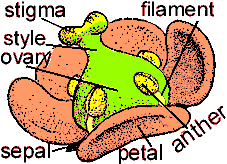
ANTHER + FILAMENT = STAMEN (male part)
STIGMA + STYLE + OVARY = PISTIL (female)
SEPALS ARE LOBES OF THE CALYX
PETALS ARE PARTS OF THE COROLLA
Blossoms come in such a bewildering variety of shapes, sizes, and basic structures that to keep from getting befuddled it helps to have some kind of "anchor." Our anchor is the "Standard Blossom," the flower drawn at the left. The Standard Blossom is nothing less than the most average, unspecialized, simple, and downright boring blossom imaginable. The value of the Standard Blossom is this:
Whenever we meet a flower that in some way differs from the Standard Blossom -- and every flower we meet will differ in at least some tiny way -- then we'll know that that difference is part of what makes our new flower special...
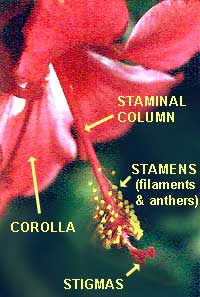 Now look at the hibiscus flower at the right, which obviously is a far cry from the Standard Blossom. However, it's typical of what flowers in "real life" are like. That is, it's obviously profoundly different from the Standard Blossom, yet its design is fundamentally the same. It has anthers which are attached to filaments, as in the Standard Blossom but, unlike the Standard Blossom, its filaments unite at their bases to form a tube, the staminal column, surrounding the flower's long style.
Now look at the hibiscus flower at the right, which obviously is a far cry from the Standard Blossom. However, it's typical of what flowers in "real life" are like. That is, it's obviously profoundly different from the Standard Blossom, yet its design is fundamentally the same. It has anthers which are attached to filaments, as in the Standard Blossom but, unlike the Standard Blossom, its filaments unite at their bases to form a tube, the staminal column, surrounding the flower's long style.
 Another difference is that the hibiscus has many stamens while the Standard Blossom has only five. Also the hibiscus has a corolla with shallow lobes, while in the Standard Blossom the corolla consists of separate petals. At the left you can see the interior of a hibiscus flower clearly showing how the stamens are united into a tube surrounding the blossom's long style. This is a different hibiscus species from the one above, one with a shorter staminal column. In the picture at the left can you see how the style splits as it emerges from the stamen tube, forming five arms, each arm ending with a stigma? We have a special page just on hibiscus flowers.
Another difference is that the hibiscus has many stamens while the Standard Blossom has only five. Also the hibiscus has a corolla with shallow lobes, while in the Standard Blossom the corolla consists of separate petals. At the left you can see the interior of a hibiscus flower clearly showing how the stamens are united into a tube surrounding the blossom's long style. This is a different hibiscus species from the one above, one with a shorter staminal column. In the picture at the left can you see how the style splits as it emerges from the stamen tube, forming five arms, each arm ending with a stigma? We have a special page just on hibiscus flowers.
Now let's look at some general statements about our Standard Blossom.
The blossom has protective parts
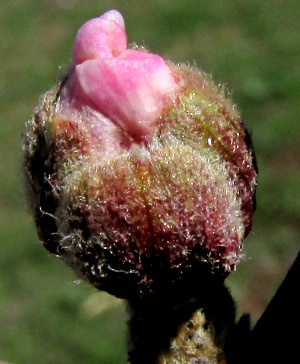
Before our Standard Blossom opens, it is folded neatly inside a small, tough, bag-like structure called a flower bud. The flower bud's tough covering protects it from insects, temperature extremes, sunlight, and other things. When it's time for the flower to burst from its bud, the bud opens like a clinched fist opening its fingers. As the blossom continues to enlarge, its former tough, green covering remains at its base, looking like a green cup with a toothed rim (shown at the right). This green cup is referred to as the calyx.

The calyx's individual teeth -- the three triangular items visible in the picture at the right -- are known as sepals. In that picture, the reddish-white items inside the cup formed by the calyx with its sepals is the pear blossom's future corolla, discussed below. The picture at the left shows the blossom's white corolla more developed. Before long the corolla will dwarf the calyx.
The blossom has animal-attracting parts
Many flowers need to attract animals, especially insects, to pollinate them. In most cases the part of the flower catching the animal's attention is the relatively large, colorful part known as the corolla. Often corollas consist of separate parts referred to as petals. Other times corolla parts are joined together like teeth on a crown, and then they're known as corolla lobes. Our Standard Blossom's corolla is divided into five distinct petals, but our Hibiscus blossom has a corolla with five lobes.
The blossom has male sexual parts
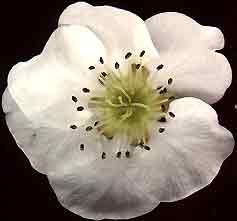
The Standard Blossom bears both male and female parts. The basic unit of the male part is known as the stamen, and our Standard Blossom has five of them, quite unlike the Pear-tree blossom at the right which has maybe 30 stamens radiating from the blossom's center. Each stamen is composed of a slender, stem-like object known as a filament, atop which is attached a smaller, thicker item looking like two frankfurters stuck together, and that is the anther. In the photo, all those little dark spots, numbering maybe 30, are the anthers held atop their slender, cream-colored filaments. When the stamen is sexually mature, its anther splits open and yellow, dust-like particles emerge; this "dust" is pollen. Pollen grains carry within them the plant's male sex germs, just as a male animal's sperm carries the male sex germ. In a way, pollen is like sperm. The hibiscus flower at the top of this page has a very special stamen arrangement. The filaments of its hundreds of stamens (not like the Standard Blossom's five or our Pear-tree's 30 or so) are united at their bases into a long, pale cylinder, which surrounds a long, stringy part of the flower's female parts....
The blossom has female sexual parts

The Standard Blossom's female sexual part is a plump object occupying the blossom's center. Known as the pistil, it's composed of three main parts. At the very top, there's a lobed thing called the stigma, where pollen is supposed to land. There's a "neck area" between the stigma and the big round part below it called the style, and the big round part itself is known as the ovary. Also you can see a couple of dark stamens, with dark purplish anthers, to the left of the pistil.
In the tulip picture you see deep inside a typical tulip flower. The erect greenish and white thing on the right side of the picture is the flower's female part, the pistil. The 3-lobed, fuzzy item at the top (fuzzy to catch pollen) is the stigma. The part that looks like a cucumber standing on its end is the ovary. Unlike our Standard Blossom, this pistil doesn't have much of a style at all. Well, that's just something special about tulip pistils. In contrast to tulips, you can see in the hibiscus flower at the top of this page that hibiscus pistils possess extremely long styles.
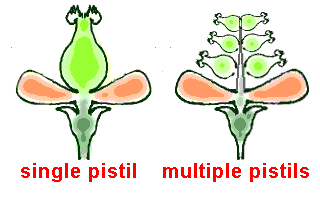
With regard to pistils, flowers are divided into two great groups: Those with a single pistil, and those with more than one. The tulip and most flowers bear just one pistil. However, the blossoms of many important kinds of plants have more than one -- such as buttercups, roses and magnolias. The diagram shown below illustrates the two strategies.
Inferior or superior ovary?
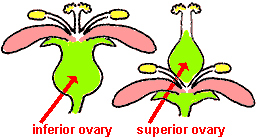
At the right you see a diagram showing one profound such difference -- based on the position of the ovary relative to the other parts. When you begin learning how to identify plants, one of the very first questions you will learn to ask yourself when presented with an unknown flower will be "Does it have an inferior or superior ovary?"
Our Standard Blossom, like most flowers you'll meet in your life, has a superior ovary, right? Though superior ovaries are the most common kind, the species in many familiar plant families have inferior ones. Members of the Iris, Honeysuckle, Squash and the huge Sunflower Families have flowers with inferior ovaries.
There are lots of other ways flowers can be different from one another, but that's enough to get us started noticing them.
It should be clear by now that much of the fun of our kind of flower sniffing is to see how real flowers differ from being what our mental image of a Standard Blossom happens to be. Some differences are subtle, but some are simply outrageous, causing some naturalists to think that maybe "God has a sense of humor... "
Another way to look at it is that beholding variations on the Standard Blossom theme is like hearing a pretty melody played in many, many innovative variations...!